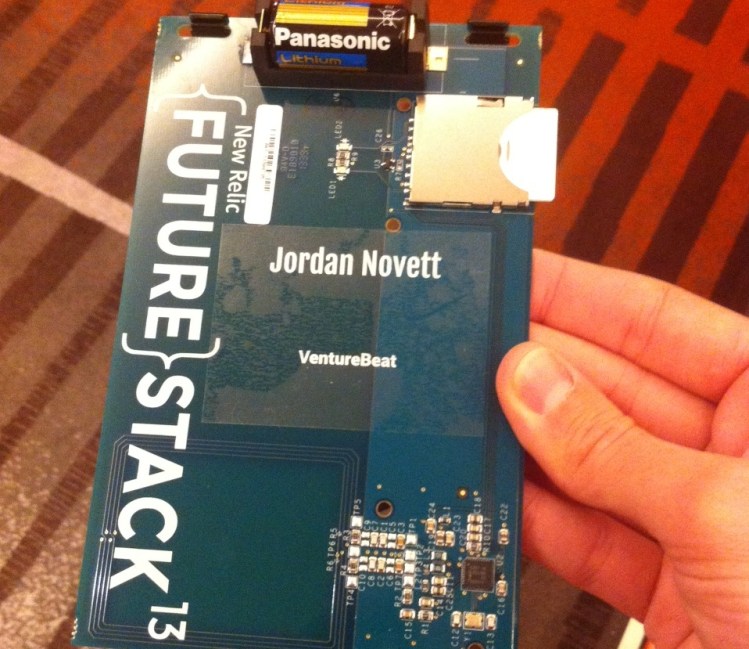SAN FRANCISCO — New Relic has hit it big in the app-performance management realm and is on track for a public offering. And now that it’s holding user conferences, it needs to get the most out of its own data. Cue the wired conference badges!
As developers filed into the FutureStack conference here Thursday, they were handed hard plastic circuit boards labeled with their names and powered by lithium batteries. Attendees can “bump” these fancy conference badges with other ones in order to exchange contact information without worrying about damaging their cell phones or losing business cards. A custom application for iOS and Android lets attendees access the data (and check out the conference schedule).
Meanwhile, New Relic is using the badges as a network of sensors for collecting data about their conference. Other companies, like Google and O’Reilly Media, have deployed a limited number of Arduinos throughout their conference venues this year in order to gather data on temperature, sound, and other metrics, but that means data input is limited. And on top of that, the users quantified in that data don’t get rewarded. That’s different with the New Relic badges, whose Electric Imp chips conference attendees can later remove and program for hardware-hacking purposes.
The DEF CON conference has given connected badges to attendees in the past, and now the concept is spreading.
Editor’s note: Our upcoming DataBeat conference, Dec. 4-Dec. 5 in Redwood City, will focus on the most compelling opportunities for businesses in the area of big data analytics and beyond. Register today!
At the New Relic conference, aggregate data on the connections attendees make with one another will be displayed on screens around the conference venue later today, New Relic developer advocate Chris Kelly said. He worked on the development of the badges and mobile applications in the past five months alongside New Relic’s Jason Snell and other employees.
“We were coming up to the conference, and much of the conference is based on the idea of software being everywhere, and so we were thinking about concepts of what does it mean to have software in all the things, right? What can happen when you put a piece of technology in something so mundane as a conference badge?” Kelly said.
The board contains a Wi-Fi chip and near-field communication capabilitiy, which allows the board to grab data about itself and send it to New Relic every few minutes. It determines location in relation to wireless base stations, as well as the board’s power levels. As a result, Kelly said, New Relic can see where people move around and try to figure out what makes them do so. They can try to determine what makes people leave a place, too. That’s on top of the bit about exchanging contact information by physically bumping them together.
This wasn’t a cheap little conference giveaway. Lots of these connected badges were built, with 1,000 people registered to attend, a spokeswoman said. But the project is worth the expense, Kelly said. Employees “were so excited about the notion of looking at our social graph of the conference,” he said. In other words, they’ll be able to see people getting to know each other.
Admittedly, these badges aren’t perfect. Mine wasn’t able to connect to my iPhone, meaning that I had to rely on good old business cards to exchange contact information. But still, there’s a smart idea at work here: Deploy more sensors to collect more data when and where it makes sense, and you could get yourself more new insights.
VentureBeat's mission is to be a digital town square for technical decision-makers to gain knowledge about transformative enterprise technology and transact. Learn More

